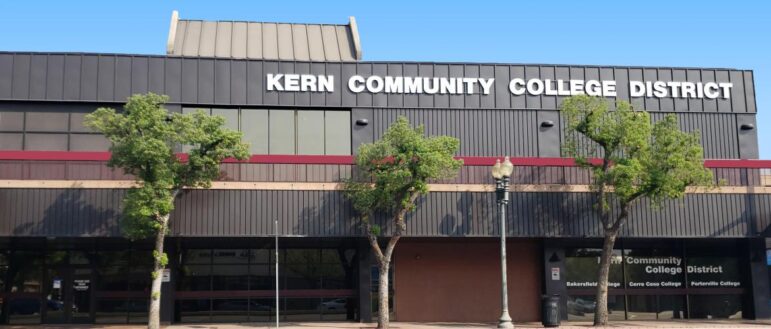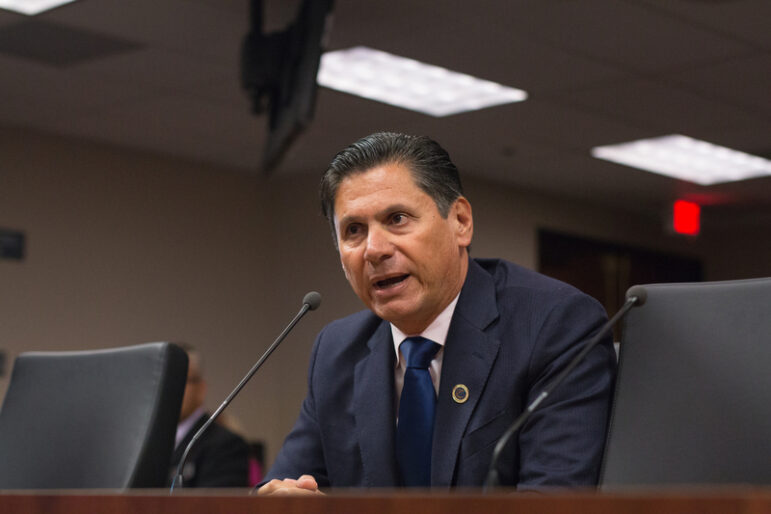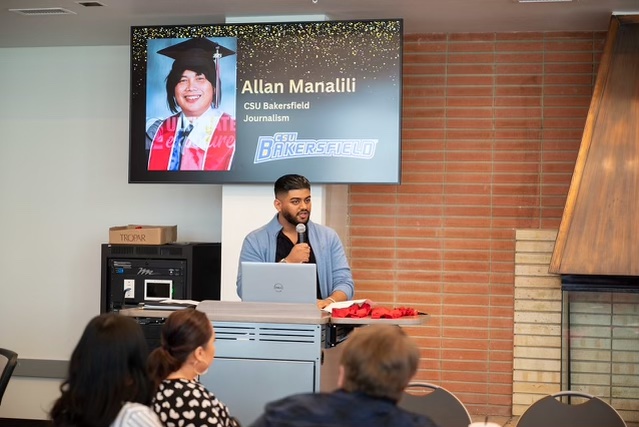Many students enroll in community college planning to transfer to the University of California or California State University.
But very few actually make it, data show.
Despite decades of legislation and calls to action to improve the transfer process, the transition from the state’s community colleges to its universities continues to be a difficult and complicated task for many students.
Researchers have long identified many of the roadblocks preventing California community college students from completing a bachelor’s degree within the UC and CSU systems. Little has changed.
“I’ve never heard anyone say, ‘I don’t want to improve transfer,’” said Eloy Oritiz Oakley, president of the College Futures Foundation and the former chancellor of the state’s 116 community colleges. “But yet, here we are.”
He’s not the only one to recognize the continuing challenges.
“I’ve been working on these issues for more than 15 years,” said Jessie Ryan, executive vice president of the Campaign for College Opportunity. “And it’s astonishing to me how challenging the transfer process continues to be for students across the state.”
A research study by Ryan’s organization found that among the students who enrolled in the community colleges in 2012, completed at least 12 credits within six years, and attempted transfer-level English or math, only 3% did. Fewer than 25% transfer after four years.
So why do so few students complete transfers after years of pledges to improve?
Itzel Ramirez, 18, a first-year student at Porterville College, who is studying biology, identified one serious obstacle to transferring.
“I have to take summer courses and, unfortunately, my school didn’t provide the courses that I needed, so I have to go to another community college that’s like 45 minutes away,” Ramirez said, adding that the class is offered Monday through Friday at Bakersfield College, which would mean a 90-minute trip each day, returning to Porterville to take an afternoon class.
“I’m wasting a lot of gas, but I don’t mind it because I need to get this done so I can go to UC Santa Barbara and become a (physician’s assistant),” she said.
Ramirez said she could’ve waited to take calculus at Porterville in the fall, but that would have caused a domino effect forcing her to take more courses to meet the UC requirement, spend more money, and delay transferring in two years.
Ramirez said the advice she got from her Central Valley campus was to “slow down” and use her financial aid to take the class in the fall.
But, she knew her aid was limited, and “when you go to a university, you don’t have that financial aid available. Then you have to get student loans, and I don’t want to use all of my financial aid here because I would get less when I transfer over there.”

Ramirez is a Cal Grant recipient, which means she has a total of four years of aid. She didn’t want to spend it all getting through community college.
The financial aid limit, and the lack of required courses being available when students need them, are just a couple of challenges for transfer students. And other challenges, many of which have been well documented and studied for more than a decade, still remain, Ryan said.
“It’s just been a constant struggle to see systems change for the benefit of students,” she said.
More than 80,000 students transfer each year from community colleges to a UC or CSU campus, according to the California Community Colleges.
More than a decade after the Associate Degree for Transfer was signed into law to ease the transition from the community colleges to the Cal State system, Oakley says the full intent of that law hasn’t been realized.
“We still have campuses like San Diego, San Luis Obispo, Northridge and other impacted campuses where it is still very difficult to transfer to the CSU,” Oakley said. At UC, it’s “sad to see that the UC faculty still haven’t embraced the transfer pathways that have been in place.”
Oakley said the No. 1 problem is culture.
“This culture that the academic senates of the CSU and the UC have, that no one should be telling them what they should do, whether it’s the Legislature or the public, that they are the most qualified people to determine what is the best course of major preparation for students coming to the CSU and the UC,” Oakley said.
Ryan said she agrees with Oakley, but she added that the culture change needs to happen among university leaders too.
“There needs to be a recognition among leadership across the state, including faculty, that transfer is broken and has been for decades,” she said.
Change, Oakley said, will need to come from the top down.
“It’s going to take the leadership of the UC Office of the President, the leadership of the CSU Chancellor’s Office to really change the culture and to be in a position where there is an actual collaboration with community college faculty and not gatekeepers,” he said.
This is not the first time the state’s higher education leaders have been called to take action. The state’s higher education leaders, including Oakley during his time as chancellor, pledged two years ago that they would commit to improving the number of students who transfer from the community colleges to the state’s public and private universities.
And while there have been some improvements, such as a new Cal State mobile and online transfer planner that will debut this fall to better help community college students understand the courses they need to attend a CSU campus, more could be done.
“The three leaders could create their own commitments to improving transfer,” Oakley said. “There is no need for regulation or legislation if they create a compact to improve transfer between the three segments. They could exercise their leadership by committing to statewide transfer goals, allocating budget resources to reaching transfer students and committing to improving transfer success once they do transfer. This would require nothing more than a willingness to lead together.”
Nathan Evans, deputy vice chancellor for academic and student affairs for the CSU system, said the universities are committed to improving transfer. In addition to the transfer planner, the system also eliminated additional admission requirements placed on students who wanted to be admitted to some campuses over capacity.
“The CSU is committed to working with all of these interests to advance equitable student success in a way that honors each university’s distinct curriculum and does not delay students’ academic progress or create undue administrative burdens,” Evans said.
UC President Michael Drake wasn’t immediately available to comment, but earlier this year, he explained that what works at Cal State for transfer may not work at UC.
“A system that works well for them, that’s terrific, and we’re happy to have that work,” Drake said in January. “That same system doesn’t apply to us. It would if we were more like they were in the opportunities that students have, in the range of majors that we offer, and the focus of what happens at the University of California. If we were more like the CSU system, then the transfer system that they use would work better for us.”
But transfer advocates said that university and community college faculty are also part of the problem.
Oakley said the university faculty senates have dragged on improvements to the transfer process but that they are not solely to blame.

“The community college faculty don’t get away with not having any accountability here,” he said, adding that they’ve been slow to align their general education requirements with university requirements. A long-standing concern from the universities has been the high number of credits students accumulate in community college when many of those credits aren’t required by the universities for transfer.
Typically, students only need 60 credits to transfer, but even with the Associate Degree for Transfer program, students earn an average 86 credits, according to a report from the Campaign for College Opportunity. Without the transfer degree, they earn more, about 90.
“In some cases, it’s easier to transfer to UC with fewer units than to go through some of the associate degree routes,” Oakley said. “I put that squarely on the community college faculty for continuing to hold on to associate degree requirements that do not align with transfer.” Chancellors of the California Community Colleges system have limited to power to force change because community college districts are run by locally elected boards.
Ryan said ultimately California needs a common, single general education transfer path for CSU and UC admission.
“The reality is the decades of inaction demonstrate that absent statewide systems change we are going to continue to lose tens of thousands of students,” she said.
But there is debate about whether such an idea would work in a state as large as California.
“There are nine UC campuses with all different requirements for their majors, and some of it overlaps, and there are 23 CSU campuses, and they have their own programs, so that’s 32 campuses each with their own programs,” said Ginni May, president of the academic senate for the California Community Colleges. “And we have 116 campuses trying to meet the requirements of 32 campuses.”
If all 32 campuses had the same exact curriculum, “then we could do that pretty easily, but they don’t,” said May who is chair of the AB 928 committee, which was created by the Legislature to make recommendations on improving transfer.
“We need to have the discipline faculty from all three systems, from all the campuses, sit down together and talk about what is absolutely needed for this major and what is not needed for transfer,” May said, adding that those conversations, however, are just starting with faculty who specialize in specific majors or programs.
And there are other problems preventing or delaying community college students from transferring, such as few counselors due to financial constraints, which delays how early students receive information on their academic paths.
Community colleges are also facing historically low enrollment. When classes are under-enrolled, administrators cancel them for budgetary reasons, and that can hamper the ability of students to stay on track, May said.
California’s transfer problems involve multiple transfer pathways from and to multiple campuses. For example, the much-heralded Associate Degree for Transfer to the Cal State system currently only includes 40 programs. The AB 928 committee is currently looking at how the ADT could expand to more science, technology, engineering and math majors.
Community college students who want to transfer outside the ADT may have to — on their own — map the classes that best match the transfer agreements made between their college and the UC or CSU campus they’re interested in attending.
But even mapping classes on their own may be a struggle.
Harvind Grewel, a Bakersfield College student who is in his last semester of community college, said his counselor recommended he use assist.org to figure out which of his courses would transfer to the universities he’s interested in attending.
But one problem cropped up when Grewel attempted to map his classes on the website to transfer to UC San Diego, he found the details were outdated and from 2011.
“They didn’t really show the classes that I had to take that would transfer from Bakersfield to UC San Diego,” said Grewel, who is studying political science. “So that came to be a little bit difficult.”
Grewel contacted the university, which he said sent him from one department to another, which “was not very helpful.” Ultimately, he found help at UC Santa Barbara, where they helped Grewel map his transition between the college and the UC system. Grewel learned this week he was accepted to Berkeley, Davis and San Diego.
The UC system doesn’t accept the ADT, but it has the Transfer Admission Guarantee program, which guarantees transfers a seat on a specific UC campus. However, UCLA, San Diego and Berkeley don’t offer TAG. UC officials have argued that those three campuses are too competitive and crowded to guarantee seats to certain groups of students.
For students like Grewel, that’s worrisome because UC promotes itself as a single competitive system.
“It does show you that there is like this distinction between those three schools and the others,” he said. “It’s like they don’t want a particular type of student who may not be well-off or they’re struggling.”
Meanwhile, efforts by the Legislature continue to get UC to fully offer the TAG program or expand the ADT to the UC system.
As part of its longtime efforts to fix transfer, the Legislature required CSU and requested UC to create another pathway — this time for incoming community college students. This fall, both university systems will unveil dual admission transfer programs that will guarantee community college students a seat at the UC or CSU campus they choose as first-year students. However, not every UC or CSU campus may be required to participate.
However, other students, even after they’ve completed the right classes, may still be denied because of their GPA.
Rene Lozano, a transfer coordinator at El Camino College in Torrance, said in some ways UC is better at transfer admissions than CSU because they take a more comprehensive approach to admitting community college students.
For example, Lozano said he’s seen some transfer students denied from some CSU campuses because their GPA wasn’t a 3.9 or higher.
“The UCs have a really good model,” Lozano said. “They don’t just ask for grades and courses taken on their application. … UCs care that the student is working 20 hours a week and that perhaps that is the reason why their GPA is not as good as it should be.”
Adding to the confusion, Lozano said, is that some Cal State campuses require transfer students to complete major preparatory classes at the community college for the program they intend to take at the university. For example, a business major may be required to take an additional accounting or math class prior to transferring.
“That inconsistency is a problem,” he said. “It’s really confusing to students to understand that Fullerton might admit them without major prep but San Diego would not. So where do you land in between those two worlds?”
Lozano said the simplest fix would be for CSU to follow UC’s lead and offer a comprehensive admissions review of transfer students.
“We can create as many pathways and as many degrees as we want to ensure we have more transfer-ready students until we’re blue in the face,” he said. “We can create tons of legislation to make every student eligible and they take all the right courses … but what’s the point of creating more transfer-ready students that are then stopped at the gate?”
EdSource receives funding from many foundations, including College Futures Foundation. EdSource maintains sole editorial control over the content of its coverage.
